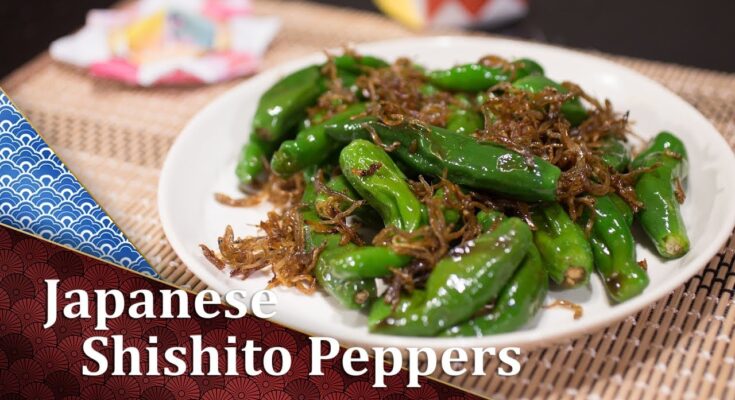Shishito Pepper Recipe: Shishito peppers have become a hot favorite, quite literally, in recent years—especially in restaurants, bars, and even home kitchens. If you’ve seen a basket of blistered green peppers served as an appetizer or bar snack, chances are they were shishitos. These little green beauties may be mild for the most part, but every now and then, you’ll bite into a spicy one. That little game of culinary roulette? Totally part of the fun.
Native to Japan, shishito peppers are now widely grown in many parts of the world, including the U.S. They’re finger-length, thin-skinned, and often slightly wrinkled. While about 90% of them are mild, the occasional spicy one keeps eaters on their toes. And because they cook so quickly and need minimal ingredients, they make for an excellent last-minute side dish or snack.
You don’t need to be a chef to whip up a fantastic batch of these. Whether you’re entertaining friends or just treating yourself to something delicious and different, shishito peppers deliver in both taste and presentation.
Let’s break down everything you need to know to make the perfect blistered shishito peppers at home.
Health Benefits of Shishito Peppers
Low-Calorie Snack
One of the reasons shishito peppers are beloved is because they’re naturally low in calories. A cup of these cooked peppers clocks in at around 20–30 calories, depending on how they’re prepared. That means you can indulge without guilt. No deep frying or heavy sauces are necessary to bring out their best flavor—just a bit of oil and a hot pan do the trick.
They’re also light on carbs and fat, making them keto and low-carb-friendly. If you’re someone who enjoys snacking but is trying to keep things healthy, blistered shishito peppers are your new best friend.
Packed with Vitamins and Antioxidants
Don’t let their small size fool you—shishito peppers are surprisingly nutrient-dense. They’re a good source of vitamin C, which is great for boosting your immune system. They also contain vitamin A and a variety of antioxidants that help fight inflammation and protect your cells from damage.
Because they’re usually cooked quickly over high heat, most of their nutritional value remains intact. So not only are they delicious, but they’re also contributing to your daily vitamin intake.
Ingredients You’ll Need for This Recipe
The beauty of this recipe lies in its simplicity. You don’t need an armful of fancy ingredients or expensive kitchen gadgets. Here’s all you’ll need:
- 1 pound of fresh shishito peppers
- 1 tablespoon of olive oil (or any high-heat oil)
- Flaky sea salt or kosher salt (to taste)
- Optional: lemon wedges, sesame seeds, garlic powder, or soy sauce for added flavor
That’s it! Just a few basics and you’re ready to make a crowd-pleasing snack or side dish.
How to Choose the Best Shishito Peppers
When it comes to getting the best flavor and texture, starting with fresh produce is key. Look for peppers that are:
- Bright green in color
- Slightly wrinkled but still firm
- Free from blemishes, dark spots, or soft patches
The size doesn’t matter as much—they naturally vary from small to medium. However, make sure they feel firm to the touch. Avoid any that seem mushy or overly wilted. If you’re buying from a farmers market, you’ll often get fresher, more flavorful shishitos than at a regular grocery store.
Once you’ve picked the perfect peppers, store them in the refrigerator until you’re ready to cook. Ideally, use them within 3–5 days for the best taste and texture.
Step-by-Step Cooking Instructions
Alright, let’s get to the good stuff—cooking these beauties. This method will give you that restaurant-style blistered look and smoky flavor, all in under 10 minutes.
Step 1: Prep the Peppers
Rinse the peppers under cool water and pat them dry thoroughly. This is crucial—excess water in the pan can cause the oil to splatter, and it also prevents the peppers from blistering properly. You can leave the stems on; they make for a nice handle when you’re eating them.
You don’t need to slice or deseed them. These peppers are typically eaten whole, seeds and all.
Step 2: Heat the Pan
Use a large cast-iron skillet or heavy-bottomed non-stick pan. Heat it over medium-high to high heat until it’s almost smoking. The goal here is to get a good sear that creates those signature blisters.
Add the tablespoon of oil and swirl it around to coat the pan evenly. Give it a few seconds to heat up before adding the peppers.
Step 3: Sauté Until Blistered
Toss the peppers into the pan in a single layer. Don’t overcrowd them—you want them to have room to blister, not steam. Let them sit undisturbed for about 1–2 minutes, then start tossing or flipping them around every few minutes.
In total, you should cook them for about 6–8 minutes until they’re evenly blistered and slightly softened. Some will char more than others—that’s okay! That smoky flavor is part of what makes them delicious.
Step 4: Season and Serve
Once they’re nicely blistered, remove them from the heat. Sprinkle generously with flaky sea salt and give them a quick toss. You can also add extra flavor here—like a squeeze of lemon, a sprinkle of sesame seeds, or a dash of soy sauce for an umami twist.
Serve them hot and enjoy immediately. They’re best eaten fresh, when they’re still warm and a little crispy.
Tips for Perfectly Blistered Shishito Peppers
Blistering shishito peppers may seem easy, and it is—but getting that perfect sear every time takes just a bit of know-how. Here are some pro tips to elevate your shishito game:
- Use a really hot pan: You want the pan smoking hot before the peppers hit it. This ensures you get that deep, smoky blister instead of a soft, steamed texture.
- Don’t crowd the pan: Too many peppers in the skillet will lower the temperature and cause them to steam. Cook them in batches if necessary to get the best result.
- Dry the peppers thoroughly: Any moisture on the peppers will prevent proper blistering and may cause the oil to splatter dangerously. Pat them bone dry before adding them to the pan.
- Toss regularly but don’t overdo it: Let the peppers sit untouched for 1–2 minutes at a time to develop the blisters. Toss or stir only occasionally to ensure even cooking.
- Add salt immediately after cooking: The salt clings better when the peppers are hot and slightly oily, giving you a more even, flavorful bite.
These small tweaks can make a big difference. The result? A sizzling bowl of perfectly blistered, slightly smoky shishito peppers that’ll disappear within minutes.
Serving Suggestions and Dipping Sauces
Sure, shishito peppers are amazing on their own, but let’s take things up a notch. Here are a few killer ideas for serving and dipping them:
Serving Suggestions:
- Appetizer platter: Pair them with olives, cheese cubes, and toasted nuts for an elevated snack board.
- Side dish: Serve alongside grilled meats, sushi, or a rice bowl.
- Tapas night: Add them to a spread of small plates like patatas bravas, marinated mushrooms, and crusty bread.
Dipping Sauces:
- Garlic Aioli: Creamy, garlicky, and just a touch of lemon—perfect with smoky peppers.
- Spicy Mayo: Mix mayo with Sriracha or gochujang for a bold kick.
- Ponzu Sauce: This citrusy soy-based Japanese sauce enhances their natural umami.
- Tahini Yogurt Dip: Earthy tahini mixed with Greek yogurt and a hint of lemon makes a dreamy dip.
Don’t be afraid to experiment with your favorite flavors. Shishitos are like a blank canvas—they play well with everything.
How to Store Leftovers
If you somehow have leftovers (though it’s rare), you can store blistered shishito peppers easily:
- Storage: Place cooled peppers in an airtight container and refrigerate. They’ll keep for about 3 days.
- Reheating: Warm them up in a skillet over medium heat for a few minutes, or briefly microwave them if you’re short on time. Note: they won’t be as crispy as fresh, but they’ll still taste great.
- Repurposing: Chop leftover shishitos and stir them into scrambled eggs, salads, rice bowls, or pasta. Their smoky flavor adds depth to lots of dishes.
Just make sure they’ve cooled before storing to avoid sogginess from condensation.
Variations and Add-Ons
Once you’ve mastered the basic recipe, there are endless ways to spice things up. Here are a few fun twists:
- Garlic Shishitos: Add minced garlic to the pan during the last minute of cooking for a fragrant kick.
- Shishito Stir-Fry: Toss cooked shishitos with soy sauce, sesame oil, and chili flakes for an Asian-style stir-fry.
- Cheesy Shishitos: Finish with a sprinkle of shredded parmesan or crumbled feta cheese while they’re still hot.
- Citrus Zing: Add zest from a lemon or lime and a quick squeeze of juice just before serving.
- Smoky Paprika: Dust them with smoked paprika or cayenne for a flavorful punch.
Feel free to get creative and make the recipe your own. These peppers are incredibly versatile and forgiving.
Common Mistakes to Avoid
Even the easiest recipes can trip people up. Avoid these common shishito pitfalls:
- Using too much oil: A light coating is all you need. Too much oil makes them greasy.
- Cooking on low heat: You won’t get that iconic blister unless the pan is hot enough. Medium-high to high is key.
- Overcrowding the skillet: This causes them to steam instead of blister. Use a big pan or cook in batches.
- Forgetting to dry the peppers: Wet peppers steam and splatter. Always dry thoroughly before cooking.
- Under-seasoning: Salt is crucial to bring out their flavor. Don’t be shy with it.
Once you’ve nailed the technique, this dish becomes a no-fail go-to for any meal or gathering.
FAQs about Shishito Pepper Recipe
What are Shishito Peppers?
Shishito peppers are a mild variety of East Asian chili peppers. Known for their thin walls and slight wrinkles, they have a vibrant green color and are typically harvested when they are young. Despite being generally mild, about one in ten peppers carries a surprising spicy kick.
How Do You Prepare Shishito Peppers?
Preparing Shishito peppers is straightforward:
- Wash the peppers thoroughly under cold water.
- Pat them dry with a towel to remove any excess moisture.
- Heat oil in a skillet over medium-high heat.
- Cook the peppers in the hot oil, turning occasionally until they blister and brown slightly, which usually takes about 6-8 minutes.
- Season as desired, commonly with sea salt or a squeeze of fresh lemon juice.
Can Shishito Peppers Be Eaten Raw?
Yes, Shishito peppers can be eaten raw and often are. They are crisp and mildly sweet when raw, making them a unique addition to salads and as a garnish. However, cooking enhances their flavor and tames any unexpected spiciness.
What Dishes Pair Well with Shishito Peppers?
Shishito peppers are incredibly versatile and can complement many dishes. They are delightful when served as appetizers, sautéed with a dash of soy sauce or tossed with sesame oil. They also make a great addition to stir-fries, pizzas, and sandwiches or as a piquant side to meat dishes.
Are Shishito Peppers Healthy?
Shishito peppers are low in calories but rich in vitamins and antioxidants. They contain vitamin C, vitamin E, and carotenoids, which can help support immune health, improve skin health, and reduce inflammation.
What is the Best Way to Store Shishito Peppers?
To keep Shishito peppers fresh, store them in the refrigerator in a plastic bag or a produce drawer. They typically last for about one to two weeks when stored properly. Avoid washing the peppers until you are ready to use them to prevent moisture-induced spoilage.
Final Thoughts
Shishito peppers are more than just a trend—they’re a delicious, nutritious, and ridiculously easy dish that belongs in every home cook’s rotation. Whether you’re new to these Japanese beauties or already a fan, this recipe gives you everything you need to nail them every time.
They’re fun, a little unpredictable, and always tasty. And best of all, you don’t need fancy tools or ingredients to get restaurant-quality results. With a hot pan, some good oil, and a pinch of salt, you’re all set to impress your guests—or just treat yourself.
So the next time you see a bag of shishito peppers at the store, grab them. You’ve got the know-how to turn them into something special.



